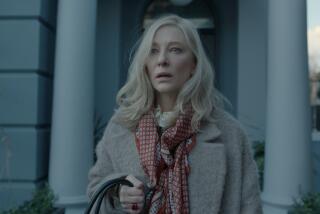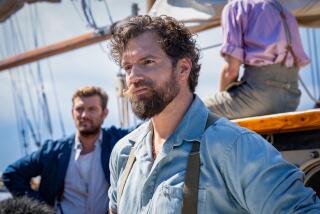‘Charlotte Gray’ Struggles for Suspense
The prospect of Cate Blanchett and director Gillian Armstrong, two of Australia’s finest gifts to the international cinema, reteaming for the first time since their audacious 1997 “Oscar and Lucinda,” could generate only high expectations.
That Blanchett is outstanding under Armstrong’s direction unfortunately makes their “Charlotte Gray,” in which she plays a British secret agent in Vichy-controlled France, all the more disappointing. Instead of the sharp and exciting World War II spy thriller with serious undertones that it is reasonable to expect from Armstrong, “Charlotte Gray,” for all Blanchett’s radiance and intelligence in the title role, is a bore.
When a member of Britain’s Special Operations Executive notices the beautiful Scotswoman Charlotte Gray reading Stendahl’s “The Red and the Black” in the original French aboard a train sometime in 1942, he strikes up a conversation and invites her to a book publishing party in London, where Charlotte is working.
At the party, Charlotte will meet a Royal Air Force pilot (Rupert Penry-Jones) on leave and swiftly embark upon a wartime romance, and she will be recruited for service in the SOE. When her new lover is shot down over France, Charlotte becomes eager to become an undercover courier with the hope of finding him if he survived.
Charlotte’s assignment sends her to a provincial town falling under stepped-up Nazi rule. As “Dominique,” she is given the cover as a housekeeper in the palatial but crumbling manor house of crusty but kindly Levade (Michael Gambon), who is sheltering two Jewish boys who escaped being transported to Poland.
Levade’s son Julien (Billy Crudup) is the fiery local leader of the Resistance, with whom Charlotte will be working closely and to whom she will become increasingly attracted once she receives word that her lover is dead.
Armstrong plays Charlotte’s discovery of herself as a strong, brave independent woman against the workings of a conventional wartime spy thriller plot. Unfortunately she and Blanchett are operating in a vacuum, for the film is devoid of thrills and offers only minimal suspense.
Armstrong and Jeremy Brock, in adapting Sebastian Faulks’ 1990 bestseller, are unsparing of the local collaborators, fueled by an anti-Semitism that lamentably continues to surface in France to this day, but this permanent stain on French honor is not exactly news.
Armstrong’s honorable attempts at seriousness, instead of trying merely for the easy escapism and romanticism of the typical World War II action-adventure, unfortunately reveal that Brock’s script is too plodding and unimaginative to work on any level--as either entertainment or commentary. For all the care expended in its craftsmanship, including a sense of authenticity in time and place, “Charlotte Gray” rarely comes alive.
It also gets no help from its leading men. If the mannered playing of Ralph Fiennes marred the otherwise dazzling “Oscar and Lucinda,” a tale of two radically different compulsive gamblers in 19th century Australia, then here Crudup and Penry-Jones are overwhelmed by the force of Blanchett’s physical presence and personality. Luckily, the always masterful Gambon and Blanchett are well-matched, but what develops between them is friendship and trust, not love and passion.
The lesson of “Charlotte Gray” is as simple as it is obvious and timeless: Strong stars and directors must be teamed with equally strong material and co-stars to succeed.
*
MPAA rating: PG-13, for some war-related violence, sensuality and strong language. Times guidelines: Elements cited are standard, even mild, for the genre.
‘Charlotte Gray’
Cate Blanchett ... Charlotte Gray
Billy Crudup ... Julien
Michael Gambon ... Levade
Rupert Penry-Jones ... Peter Gregory
A Warner Bros. presentation in association with Filmfour and Senator Film of an Ecosse Films and Pod Film production. Director Gillian Armstrong. Producers Sarah Curtis and Douglas Rae. Executive producers Paul Webster, Robert Bernstein, Hanno Huth. Screenplay Jeremy Brock; based on the novel by Sebastian Faulks. Cinematographer Dion Beebe. Editor Nicholas Beauman. Music Stephen Warbeck. Costumes Janty Yates. Production designer Joseph Bennett. Art directors Tatiana Lund, Sue Whitaker. Set decorator Joanne Woollard. Running time: 1 hour, 58 minutes.
Exclusively at Westside Pavilion Cinemas, 10800 West Pico Blvd., West L.A., (310) 475-0202; and Monica 4-Plex, 1332 2nd. St., Santa Monica, (310) 394-0741.
More to Read
Only good movies
Get the Indie Focus newsletter, Mark Olsen's weekly guide to the world of cinema.
You may occasionally receive promotional content from the Los Angeles Times.










